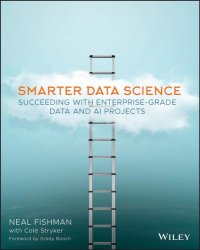
Ebook: Smarter data science: succeeding with enterprise-grade data and ai projects
Author: Fishman Neal, Stryker Cole
- Tags: Business--Databases--Management, Database management, Information storage and retrieval systems--Reliability, Management information systems, Business -- Databases -- Management, Information storage and retrieval systems -- Reliability
- Year: 2020
- Publisher: John Wiley and Sons
- City: Indianapolis
- Language: English
- pdf
Organizations can make data science a repeatable, predictable tool, which business professionals use to get more value from their data Enterprise data and AI projects are often scattershot, underbaked, siloed, and not adaptable to predictable business changes. As a result, the vast majority fail. These expensive quagmires can be avoided, and this book explains precisely how.' Data science is emerging as a hands-on tool for not just data scientists, but business professionals as well. Managers, directors, IT leaders, and analysts must expand their use of data science capabilities for the organization to stay competitive. Smarter Data Science helps them achieve their enterprise-grade data projects and AI goals. It serves as a guide to building a robust and comprehensive information architecture program that enables sustainable and scalable AI deployments. When an organization manages its data effectively, its data science program becomes a fully scalable function that's both prescriptive and repeatable. With an understanding of data science principles, practitioners are also empowered to lead their organizations in establishing and deploying viable AI. They employ the tools of machine learning, deep learning, and AI to extract greater value from data for the benefit of the enterprise. By following a ladder framework that promotes prescriptive capabilities, organizations can make data science accessible to a range of team members, democratizing data science throughout the organization. Companies that collect, organize, and analyze data can move forward to additional data science achievements: -Improving time-to-value with infused AI models for common use cases -Optimizing knowledge work and business processes -Utilizing AI-based business intelligence and data visualization -Establishing a data topology to support general or highly specialized needs -Successfully completing AI projects in a predictable manner -Coordinating the use of AI from any compute node. From inner edges to outer edges: cloud, fog, and mist computing When they climb the ladder presented in this book, businesspeople and data scientists alike will be able to improve and foster repeatable capabilities. They will have the knowledge to maximize their AI and data assets for the benefit of their organizations.;Cover -- Praise For This Book -- Title Page -- Copyright -- About the Authors -- Acknowledgments -- Contents at a Glance -- Contents -- Foreword for Smarter Data Science -- Epigraph -- Preamble -- Chapter 1 Climbing the AI Ladder -- Readying Data for AI -- Technology Focus Areas -- Taking the Ladder Rung by Rung -- Constantly Adapt to Retain Organizational Relevance -- Data-Based Reasoning Is Part and Parcel in the Modern Business -- Toward the AI-Centric Organization -- Summary -- Chapter 2 Framing Part I: Considerations for Organizations Using AI -- Data-Driven Decision-Making; Using Interrogatives to Gain Insight -- The Trust Matrix -- The Importance of Metrics and Human Insight -- Democratizing Data and Data Science -- Aye, a Prerequisite: Organizing Data Must Be a Forethought -- Preventing Design Pitfalls -- Facilitating the Winds of Change: How Organized Data Facilitates Reaction Time -- Quae Quaestio (Question Everything) -- Summary -- Chapter 3 Framing Part II: Considerations for Working with Data and AI -- Personalizing the Data Experience for Every User -- Context Counts: Choosing the Right Way to Display Data; Ethnography: Improving Understanding Through Specialized Data -- Data Governance and Data Quality -- The Value of Decomposing Data -- Providing Structure Through Data Governance -- Curating Data for Training -- Additional Considerations for Creating Value -- Ontologies: A Means for Encapsulating Knowledge -- Fairness, Trust, and Transparency in AI Outcomes -- Accessible, Accurate, Curated, and Organized -- Summary -- Chapter 4 A Look Back on Analytics: More Than One Hammer -- Been Here Before: Reviewing the Enterprise Data Warehouse -- Drawbacks of the Traditional Data Warehouse -- Paradigm Shift; Modern Analytical Environments: The Data Lake -- By Contrast -- Indigenous Data -- Attributes of Difference -- Elements of the Data Lake -- The New Normal: Big Data Is Now Normal Data -- Liberation from the Rigidity of a Single Data Model -- Streaming Data -- Suitable Tools for the Task -- Easier Accessibility -- Reducing Costs -- Scalability -- Data Management and Data Governance for AI -- Schema-on-Read vs. Schema-on-Write -- Summary -- Chapter 5 A Look Forward on Analytics: Not Everything Can Be a Nail -- A Need for Organization -- The Staging Zone -- The Raw Zone; The Discovery and Exploration Zone -- The Aligned Zone -- The Harmonized Zone -- The Curated Zone -- Data Topologies -- Zone Map -- Data Pipelines -- Data Topography -- Expanding, Adding, Moving, and Removing Zones -- Enabling the Zones -- Ingestion -- Data Governance -- Data Storage and Retention -- Data Processing -- Data Access -- Management and Monitoring -- Metadata -- Summary -- Chapter 6 Addressing Operational Disciplines on the AI Ladder -- A Passage of Time -- Create -- Stability -- Barriers -- Complexity -- Execute -- Ingestion -- Visibility -- Compliance -- Operate -- Quality.
Download the book Smarter data science: succeeding with enterprise-grade data and ai projects for free or read online
Continue reading on any device:

Last viewed books
Related books
{related-news}
Comments (0)